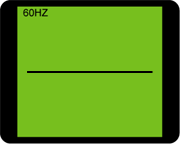|
SiliconSignature
F-128A Model
(for full specification
please click here)
Features:
Small
compact design
Use
latest graphic LCD panel instead of CRT
Use
Analogue Signature Analysis technology
Repair
circuit boards even without circuit
diagram
Test electronic components without removing
them from the PCB
Built
in shorts detection and beeping function
Built
in protection circuit to avoid damaged
by accidentally measuring high voltage
capacitor(without discharged)
Sleep
mode to save power
Product Introduction
SiliconSignature is a low cost and simple easy to use instrument
that is specially designed for modern repair environment (from TV, Video
player, VCD to computer main boards, monitors, printer control/driver
boards and all kinds of power supply). Basically it can be used to diagnose
any type of components whether it is a simple transistor or latest Pentium
processor. The best of all is you can do fault-finding on a board by either
comparing the analog signature or using your former experience to judge,
even without having the circuit diagram. It tests components in power
off condition to avoid further damage, especially suitable for power supply
repair.
How does it work?
The SiliconSignature works by applying a current-limited AC signal across
two points of a component. The Current flow causes a vertical deflection
of the LCD display, while the voltage causes a horizontal deflection.
Together, they give you a unique current-voltage "analog signature"
that represents the overall health of the device-under-test. You can quickly
tell if a component is good, bad, or marginal by either comparing the
signature with the one from the same component on a good board or recalling
your former experience with simular circuit and component such as those
signatures shown in the following page.
Simple easy to
use
It has only one rotary switch and one button in front of the panel for
easy selecting of four different test voltages and frequencies. Its test
voltage output can be as low as 1.8V, which make it ideal for testing
high value capacitors and also safe for testing 3V logic devices. A 128
X 128dot graphic LCD panel with backlight gives you crystal clear display.
Shorts detect
feature
It comes with a built in short detection circuit. This feature is very
useful when you are looking for a connection between two IC pins since
the tracks on the PCB are sometimes very complicated and hard to follow
visibly (especially multi-layer board).All you need to do is to scan all
the components pins around that area until you hear a beep. The principle
of this is that the voltage between two probes drops almost to 0 V if
it's testing something that is shorted. So a built in circuit keeps measuring
this voltage, when it drops below a preset certain value the circuit will
cause a beep. But sometimes it causes beeping as well when measuring a
capacitor which value is over 1000uF.To verify that, you simply change
it to 35Hz and XL 1.8V range to test again.
Protection circuit
In case of accidentally measuring a high voltage capacitor without discharged,
the protection circuit will take effect and only the F1 fuse is blew up.
All you need to do to get it back to work again is to replace the fuse.
Comparison between
test instruments
Among three major test instrument: Oscilloscope,DVMs(such as Multimeter)
and SiliconSignature.
The Oscilloscope can only be used in a place where the components to be
tested is in power on condition so the waveform or voltage of the signal
can be measured. However, for SiliconSignature, the components to be tested
have to be powered off and the instrument generates the test signal and
measure it as well. The advantage of this techniques is most of the faulty
components may be able to be replaced before power on and that will prevent
the circuit from further damage. This is especially ideal for repairing
power supply.
DVMs can be used either in power on or off condition. In power off condition,
it mainly used for measuring the resistance of the components. The reading
of it is limited to one-dimensional information compare with two-dimensional
Analog Signature in SiliconSignature. The SiliconSignature has 4 different
frequency selections and 4 voltage ranges resulting in totally 16 different
combinations.
|








